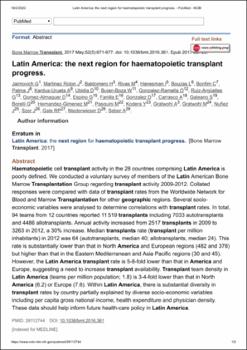Latin America: the next region for haematopoietic transplant progress.

View/
Date
2017-05-01Author
Jaimovich, G.
Martinez Rolon, J.
Baldomero, H.
Rivas, M.
Hanesman, L.
Bouzas, L.
Bonfim, C.
Metadata
Show full item recordAbstract
Haematopoietic cell transplant activity in the 28 countries comprising Latin America is poorly defined. We conducted a voluntary survey of members of the Latin American Bone Marrow Transplantation Group regarding transplant activity 2009-2012. Collated responses were compared with data of transplant rates from the Worldwide Network for Blood and Marrow Transplantation for other geographic regions. Several socio-economic variables were analysed to determine correlations with transplant rates. In total, 94 teams from 12 countries reported 11 519 transplants including 7033 autotransplants and 4486 allotransplants. Annual activity increased from 2517 transplants in 2009 to 3263 in 2012, a 30% increase. Median transplants rate (transplant per million inhabitants) in 2012 was 64 (autotransplants, median 40; allotransplants, median 24). This rate is substantially lower than that in North America and European regions (482 and 378) but higher than that in the Eastern Mediterranean and Asia Pacific regions (30 and 45). However, the Latin America transplant rate is 5-8-fold lower than that in America and Europe, suggesting a need to increase transplant availability. Transplant team density in Latin America (teams per million population; 1.8) is 3-4-fold lower than that in North America (6.2) or Europe (7.6). Within Latin America, there is substantial diversity in transplant rates by country partially explained by diverse socio-economic variables including per capita gross national income, health expenditure and physician density. These data should help inform future health-care policy in Latin America.

